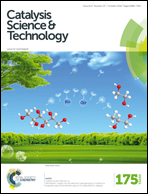Plasmonic Au/TiO2 nanostructures for glycerol oxidation†
Abstract
Au nanoparticles supported on P25 TiO2 (Au/TiO2) were prepared by a facile deposition-precipitation method with urea and investigated for surface plasmon-assisted glycerol oxidation under base-free conditions. Au/TiO2 samples were characterized in detail by X-ray diffraction, UV-vis spectroscopy, transmission electron microscopy and energy-dispersive X-ray spectroscopy. The adopted synthetic methodology permits deposition of Au nanoparticles with similar mean particle sizes up to 12.5 wt% loading that allows for the evaluation of the influence of the Au amount (without changing the particle size) on its photocatalytic performance for glycerol oxidation. The reaction conditions were optimized by carrying out a systematic study with different Au loadings on TiO2, reaction times, temperatures, catalyst amounts, O2 pressures and Au particle sizes for photocatalytic reactions as well as traditional heterogeneous catalysis. It has been shown that visible light irradiation during the reaction has a beneficial effect on the conversion of glycerol where the best catalytic results were observed for 7.5 wt% Au loading with an average particle size of around 3 nm. The main product observed, with selectivities up to 63%, was high-value dihydroxyacetone that has important industrial applications, particularly in the cosmetic industry.


 Please wait while we load your content...
Please wait while we load your content...